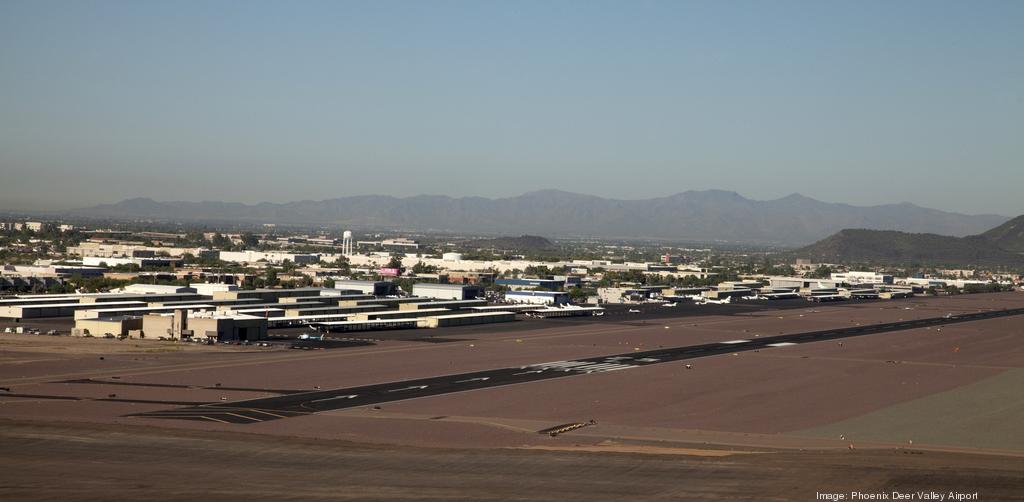
Remaining properties around the Phoenix Deer Valley Airport continue to be built out with more industrial buildings to meet the ongoing demand for space from semiconductor suppliers and other companies looking to expand in north Phoenix.
The Deer Valley submarket has industrial projects in the works by major developers such as Mack Real Estate Group, Hopewell, Opus, Ryan Cos. and Sunbelt Investment Holdings Inc.
Skip Corley, an executive vice president at DAUM, said about 2 million square feet of industrial space is getting ready to deliver this spring while plans for future phases of industrial projects are underway.
"Typically developers don't want to start a second phase until they feel like they've got enough leasing and pre-leasing on the first phase to do that," Corley told the Business Journal.
Of the 2 million square feet that's close to being completed, about 60% of this has been pre-leased, Corley noted.
The Deer Valley airport area is located north of the Loop 101 and east of Interstate 17 and is about six miles south of the under-construction Taiwan Semiconductor Manufacturing Co. project. Some of the existing major employers that are already located in the area include USAA, Honeywell Aerospace, Amazon and FedEx.
Last year, the airport estimated that the surrounding area will see a demand of about 7.4 million square feet of logistics warehouses, flex industrial and flex office by 2028.
Huge land auction near TSMC set for May
Demand has been driven in part by semiconductor suppliers.
"This obviously is the closest existing industrial to TSMC and the closest that will have infrastructure in place that new companies could build," Corley said. "Anything around TSMC is at least three to five years away."
Mack Real Estate Group applied for a state land auction for more than 2,300 acres surrounding TSMC, which has been scheduled for May with a starting bid of $56.28 million. The area is expected to turn into a major technology center.
Currently the Deer Valley submarket has an approximately 6.5% vacancy rate. The area has always had a tight vacancy but it dropped even further after TSMC announced its project, Corley said.
Activity is also being driven by companies already in the area and by those who want to service north Phoenix. Not everyone wants to be located along the Loop 101 or Loop 303, Corley added.
Last year, Colgate-Palmolive Co.'s skin-care businesses signed onto about 100,000 square feet at Mack Innovation Park, a larger 3.5 million square-foot park at full buildout. Semiconductor supplier Sunlit Chemical is also located there.
Fox Factory Inc., a performance product manufacturer for cars, motorcycles and off-road vehicles, signed a lease last year for 112,000 square feet north of the airport at 17 North Corporate Center. Trackman Golf, a Danish sports technology company, leased a 40,529-square-foot space at 525 E. Pinnacle Peak Road after leaving its facility in Scottsdale.
Deer Valley space a hot commodity
With tenants still looking for space, especially smaller and mid-sized warehouses, developers continue to pursue Deer Valley, said Bob Lundstedt, an executive vice president for DAUM. Typically, Deer Valley's sweet spot has been tenants looking for 25,000 to 60,000 square feet.
"Developers that I know have said, 'we only want to be in two markets — Deer Valley and Tempe, if they can find an infill site," Lundstedt said. "I think Deer Valley is still the 'it girl.'"
Baker Development Corp., which has several projects across the Valley such as the former Motorola campus in Phoenix, is preparing to start construction on two new buildings totaling 70,000 square feet and 130,000 square feet near Deer Valley Road and Interstate 17.
Daniel Slack, president and COO for Baker Development, said they expect to construction on the facilities by summer with an estimated deliver of early 2025.
"It's obviously a very active market and pretty low vacancy," Slack told the Business Journal. "In typical fashion, our properties are highway-frontage properties. ... Users all things being equal like the ability to build their brand and have that highway exposure."
The submarket's adjacency to TSMC and the space needed to support potential suppliers is also part of what drew Baker Development to the area, Slack said. Their company has also tried to position its projects across the Valley as opposed to one area.
"It's a diversification strategy but also being opportunistic and recognizing the market was a strong market before TSMC and it's just a much more stronger market today as a result and will continue to be," Slack said.
Airport presents growth opportunities
In addition to land around the airport, the Deer Valley Airport had about 186 acres across four sites available for development as of 2023, according to airport estimates.
Future growth opportunities for the Deer Valley Airport could include new entry and exit points; taxiways and connectors; corporate aircraft hangars, general aviation T-hangars; maintenance, repair and overhaul services; aircraft manufacturing or additional fixed base operators.
Ed Faron, Deer Valley Airport manager, said it's possible executive staff at the Taiwan Semiconductor Manufacturing Co. could choose to fly in and out of DVT.
"At some point in the future this may create a need for Customs and Border Protection services at the airport," he said in an email through a spokesperson. It is possible that ... some of the thousands of workers at TSMC could be pilots who would want to use DVT as their home airport."